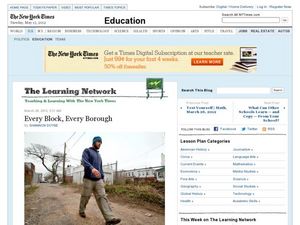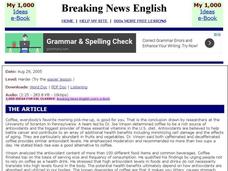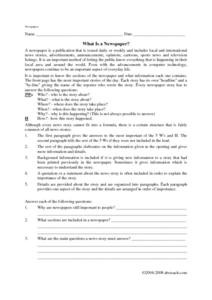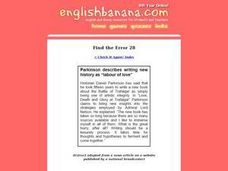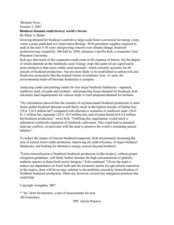Curated OER
"Every Block, Every Borough"
From the New York Times Learning Network series, this activity poses 10 questions on an article entitled, "Leaving His Footprint on the City" about a man planning to walk every street in all five New York boroughs. The prompts...
Curated OER
On the Dots
If you want your class to practice reading informational texts and answering related questions, this short exercise from The New York Times' "Learning Network" might be helpful. It includes an article on Dippin' Dots and uses...
Curated OER
Reading about Recent Exhibits in the Art and Design Section
A large part of analyzing or understanding art is knowing how to read about it. The New York Times has put together these who, what, where, when, and how questions to aid learners in comprehending informational pieces related to art and...
Deliberating in a Democracy
Free and Independent Press
Students determine how free press principles can be compromised. For this global studies lesson, students read an article titled "Free and Independent Press." Students respond to discussion questions regarding the article.
Arizona State University
Journalism Lesson
Engage your pupils in a seres of journalism activities. For this journalism lesson plan, learners practice with AP style, analyze an article, practice writing leads, work with organizing information, and take a stab at writing headlines....
Curated OER
Breaking News English: Coffee
In this coffee worksheet, students read the article, answer true and false questions, complete synonym matching, complete phrase matching, complete a gap fill, answer short answer questions, answer discussion questions, write, and more...
California Education Partners
Summer Olympics
Quickly get to the decimal point. The last assessment in a nine-part series requires scholars to work with decimals. Pupils compare the race times of several athletes and calculate how much they have improved over time. During the second...
Curated OER
Creating a Newspaper
Get the scoop with a fun, engaging newspaper project. After analyzing the parts of a newspaper, including the headline, subtitles, and pictures or images, young journalists get to work by writing their own stories in a newspaper article...
Clever Student Training Company
Analyzing the Essay
The skill set required of readers of informational text includes the ability to identify an article’s thesis or main idea, as well as the supporting points. Learners can practice these skills by analyzing an essay about the treatment of...
Curated OER
Journal Assignment Directions
In this journalism analysis worksheet, students choose and editorial article and analyze the content. Students will write articles with a minimum of 350 words.
Curated OER
Worksheet for Analysis of a Newspaper Article
In this primary source analysis worksheet, students respond to 20 short answer questions that require them to analyze their selected newspaper articles.
Curated OER
The Learning Network: The First Middle School Chess Champs
Introduce some nonfiction reading into your classroom! This resource contains seven comprehension questions pertaining to an article from The New York Times website about the first middle schoolers to ever win the United States Chess...
Curated OER
What Is a Newspaper?
In this journalism activity, students read and analyze an article about newspapers and complete a variety of activities along with answering twenty four comprehension questions.
Curated OER
Walking Fast a Sign of Longer Life
In this English learning exercise, students discuss walking. Students conduct a survey about walking, write a short piece on walking, listen to and read an article about walking.
Curated OER
"The" Or nothing?
In this "the" or nothing worksheet, 7th graders review, analyze and discuss when its appropriate to use definite pronouns. Students add the definite article "the" to ten sentences as required.
Curated OER
Not Getting the News about the Stamp Act
How did American colonists react to the Stamp Act of 1765? Your young historians will examine primary source material by reading excerpts from a transcription of the Pennsylvania Gazette and then identifying the sentiments expressed...
Bowland
Public Transport
"Statistics is the grammar of science" -Karl Pearson. In the assessment task, learners read a claim made by a newspaper and analyze its conclusions. They need to think about the sample and the wording of the given statistics.
Curated OER
Review of Yes/No Questions
In this yes and no questions instructional activity, students read a 2-paragraph news story and then write 5 questions that may be answered with the provided answer statements.
Curated OER
Find the Error 28
In this find the error worksheet, students read and analyze an extract from a news article and then determine the grammar mistakes found in the article involving apostrophes, articles, punctuation and spelling.
Curated OER
Lesson 3: Making Predictions
In this making predictions worksheet, students read a newspaper article, locate the "Five Ws and the H," and then make logical predictions on the content that they read and then analyze those predictions based on a rubric.
Balanced Assessment
Confetti Crush
In the first part of a middle school assessment task, learners analyze a given statement about the amount of confetti revelers throw at Times Square on New Year's Eve. The second part of the task requires learners to identify objects...
Curated OER
Biodiesel Demand Could Destroy World's Forests
In this global issues worksheet, students read a 1-page article about biodiesel demand then write PPC articles that address the costs of biodiesel use.
Beacon Learning Center
Growth of a Revolution-The Industrial Revolution
How did changes of the agricultural revolution in eighteenth century Great Britain influence the Industrial Revolution that followed? How were inventions and processes of the Industrial Revolution interrelated? This resource includes a...
Curated OER
Cartoons for the Classroom: Keep Current Through a Cartoonist's Commentary
In this current events worksheet, students analyze political cartoons about the Middle East and American domestic issues. Students respond to 4 talking point questions.


